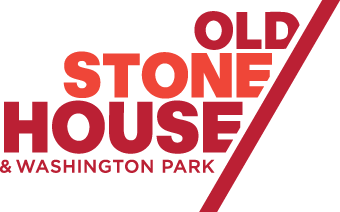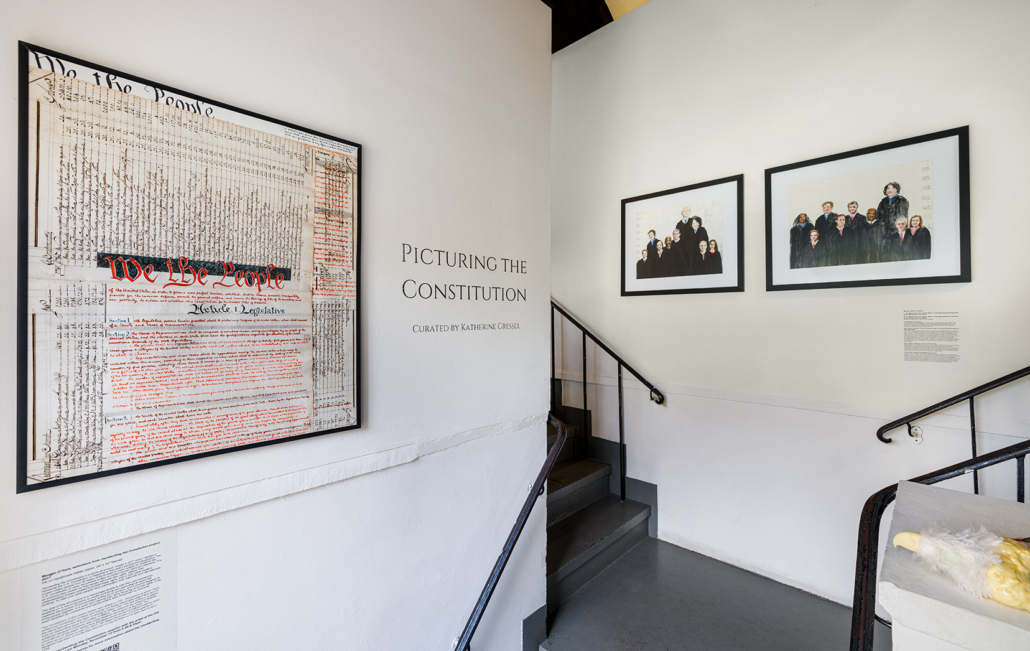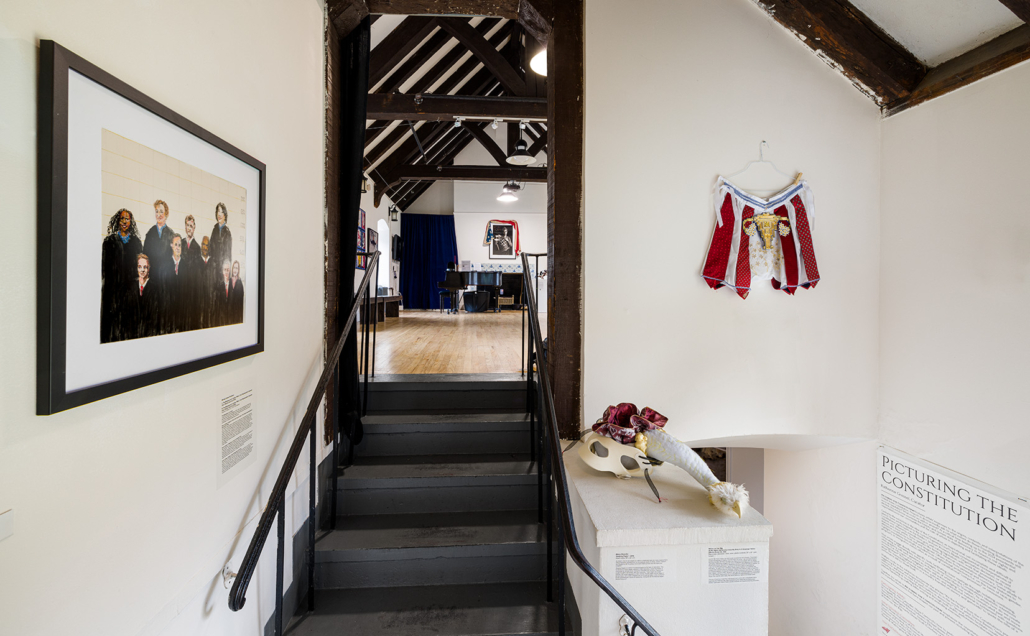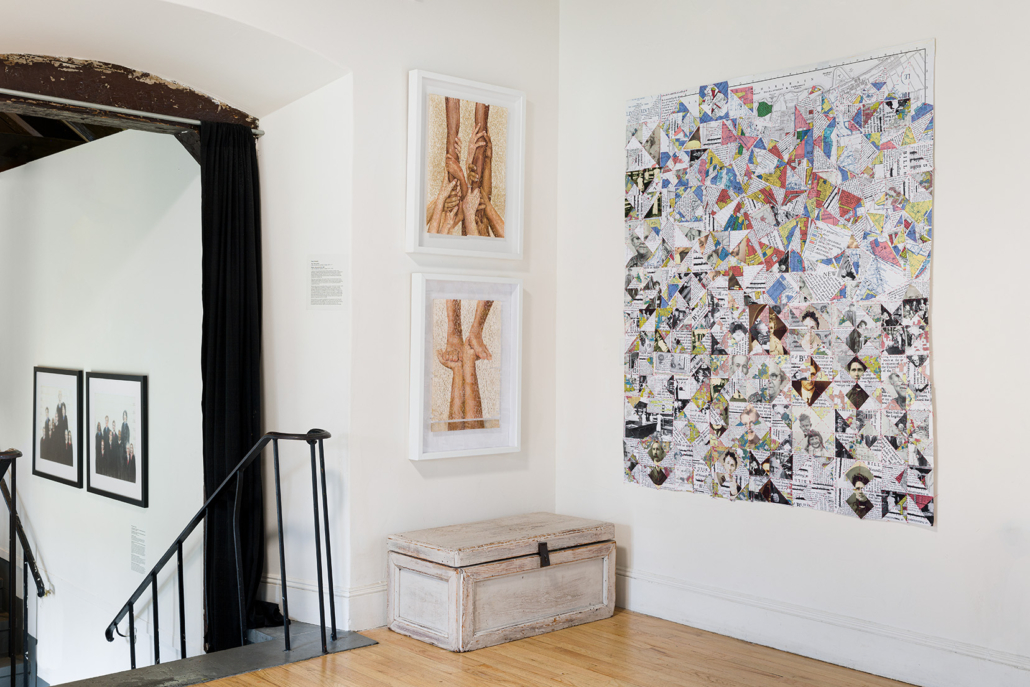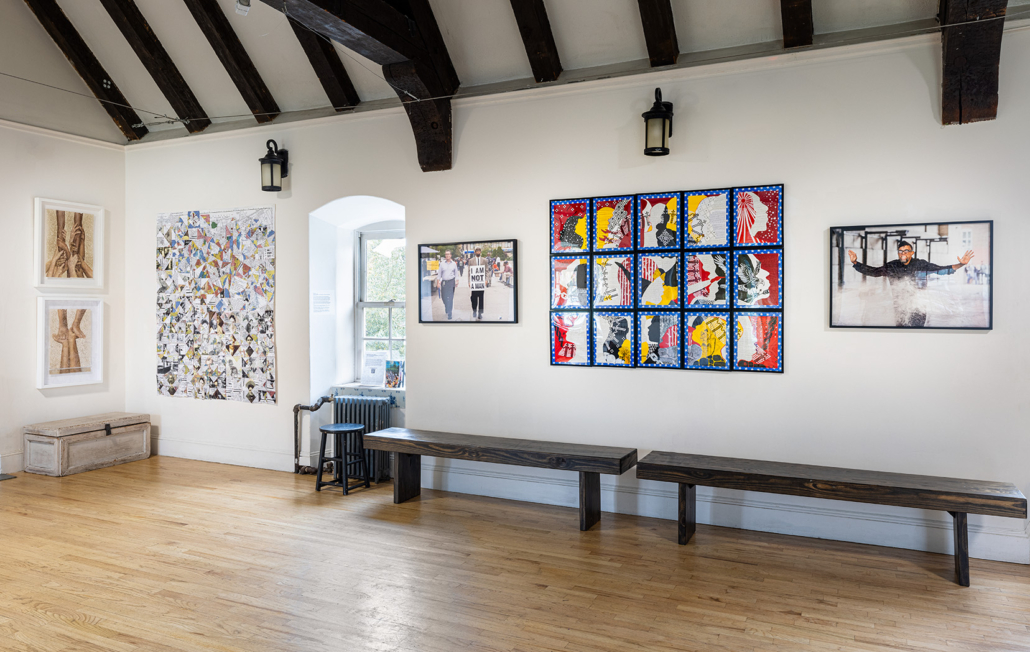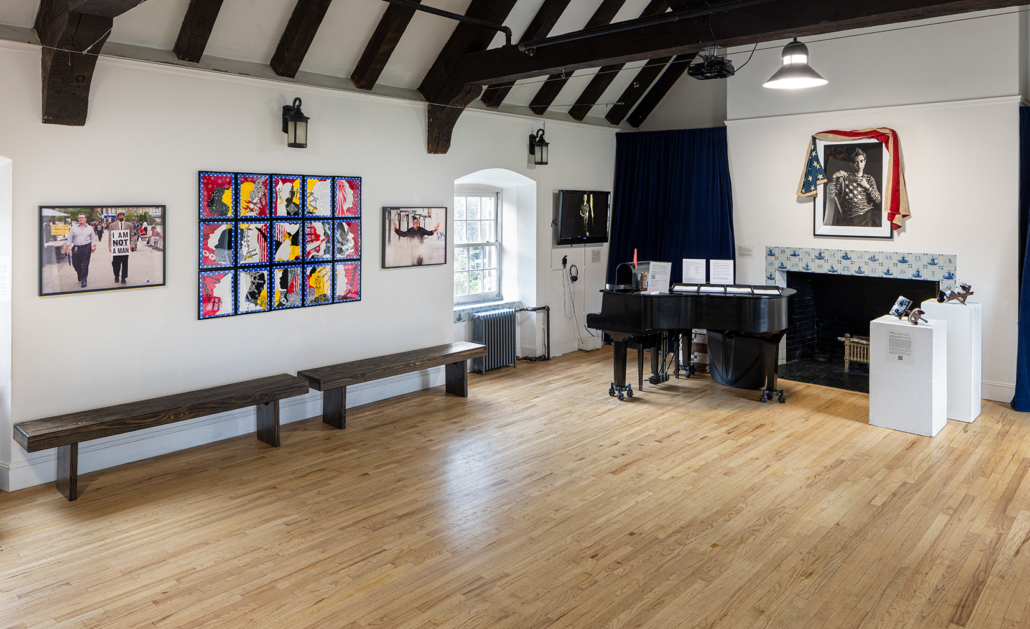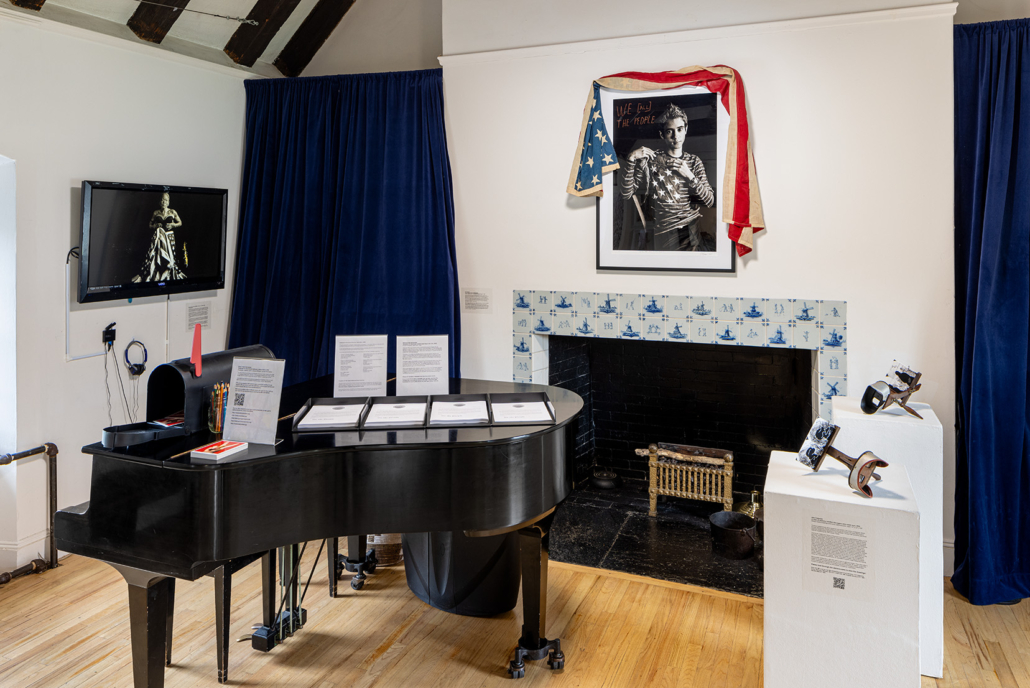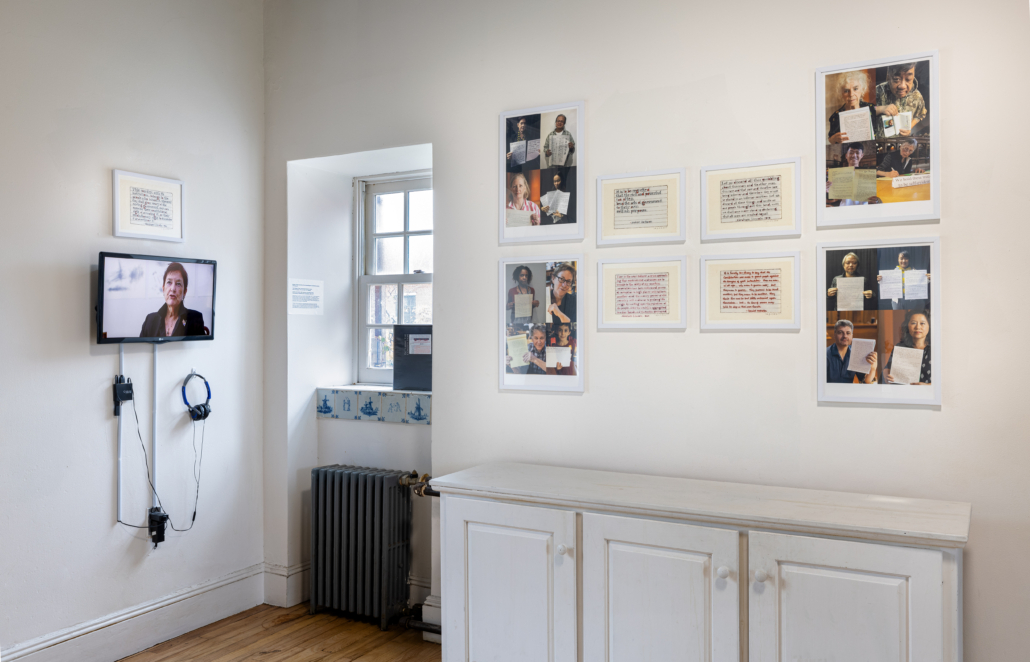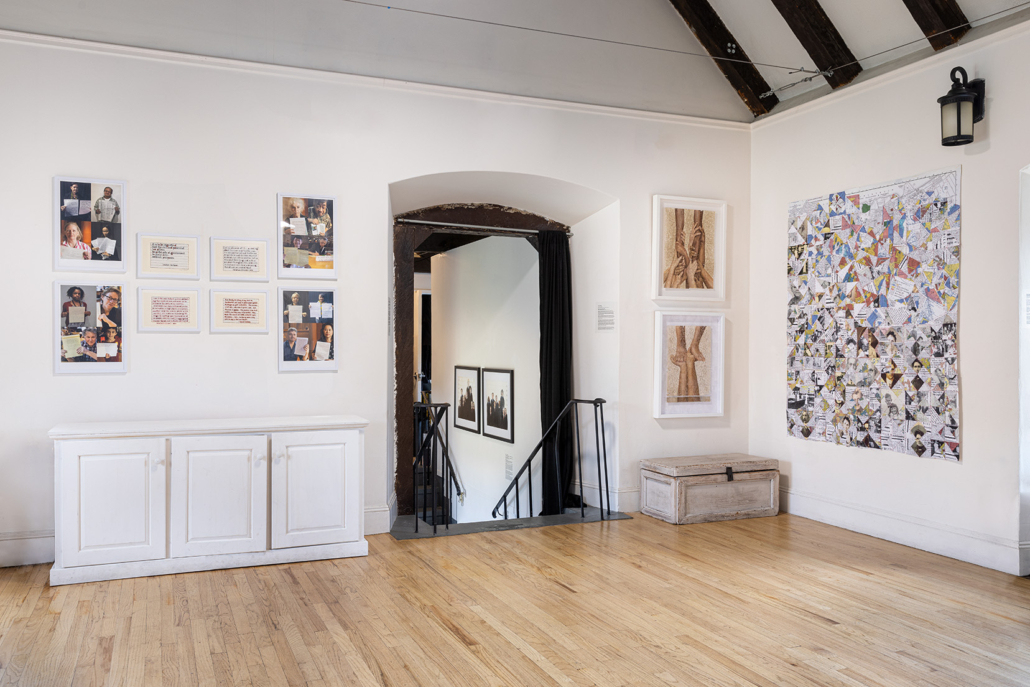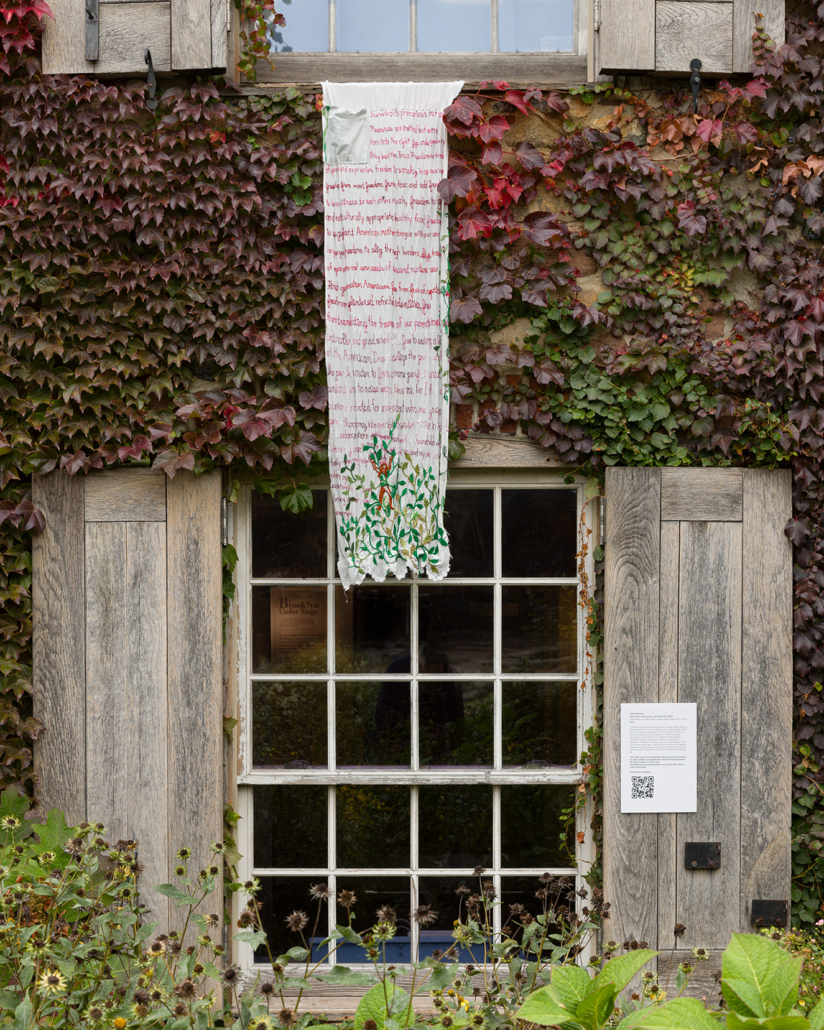This Exhibit is past. Visit our Exhibitions page for information on the current programming.
Little Lace: The Work of Brooklyn Lace Guild
October 10, 2024 – January 11, 2025
Opening Reception: October 10, 2024, 6:00 – 8:00 pm
Gallery Hours: Friday – Sunday, Noon – 4 pm
Showcasing original works on an intimate scale that reflect upon concepts of identity, memory, gender, technology, history, and the natural world, Little Lace features contemporary lace art created by members of Brooklyn Lace Guild (BLG). Here the word “lace” refers to a variety of refined fiber techniques that were traditionally used to make textiles for fashion and furnishings, as well as the appearance and aesthetic of lace reimagined in other media.
Born in Brooklyn, BLG was founded in 2016 by Elena Kanagy-Loux, Kaelyn Garcia, and Devon Thein to make, study, preserve, and promote both historic and contemporary lace. Guild members include graduates of New York’s art schools, employees of commercial and non-profit arts institutions, and artists, scholars, and students working in and outside of academia. As a result, the making of contemporary lace using traditional techniques plays an important role in this diverse lace group and serves to differentiate it from other lacemaking associations. Now numbering over fifty members, BLG meets monthly to discuss, analyze, and make lace together. Through a variety of virtual and in-person events, guild members engage in lace workshops and exhibitions, as well as lace viewings and museum tours in the New York City metro area. Since its founding, BLG has collaborated with a number of major cultural institutions including the Antonio Ratti Textile Center at the Metropolitan Museum of Art, the Yale Center for British Art, and Bard Graduate Center on lace-related events and exhibitions.
Little Lace features more than twenty-five works addressing topics of nature, sustainability, and the juxtaposition of lace with contemporary digital and industrial environments. Several pieces explore family narratives and heritage, while others evoke family members who made lace, thereby stressing the importance of intergenerational transmission of pre-industrial craft traditions and the necessity of protecting living craft communities. Another common theme in this exhibition is the experience of being a woman; several works address women’s roles as anonymous makers of textiles throughout history, under- appreciated and yet of great cultural significance. Many also touch upon broader inequities, including intergenerational trauma, illness such as cancer, and the discomfort of menopause. Numerous artists also reflect on the contemplative nature of lacemaking, a slow process that promotes meditation as a soothing escape from the world. The featured artists utilize a wide range of techniques, from bobbin lace, needle lace, tatting, knitting, and crocheting to alternative media such as encaustic, reflective drawing, and cyanotype. In using traditional materials such as silk and cotton thread as well as unexpected media including trash bags, electrical wire, human hair, and other found objects, or by translating lace motifs into other fine art forms, each artist reinterprets historical techniques through a contemporary lens that bridges past and present and invites visitors to consider both the history and the innovative future of this fascinating global textile.
Participating Artists:
Sasha Baskin
Padina Bondar
Ev Christie
Glorimar Garcia
Jen Chen-su Huang
Enjoy this virtual tour slide show of the exhibition, photographed by Etienne Frossard.
Public Programs:
Opening Reception: October 10, 2024, 6:00 – 8:00 PM
FREE Drop-In Cynotype Workshop at Fiber Festival: October 12, 2:00 – 5:00 PM
Tatting with Ellyane Hutchinson: October 28, 6:30 – 9:30 PM
Bobbin Lace with Elena Kanagy-Loux: November 18, 6:30 – 9:30 PM & January 6, 6:30 – 9:30 PM
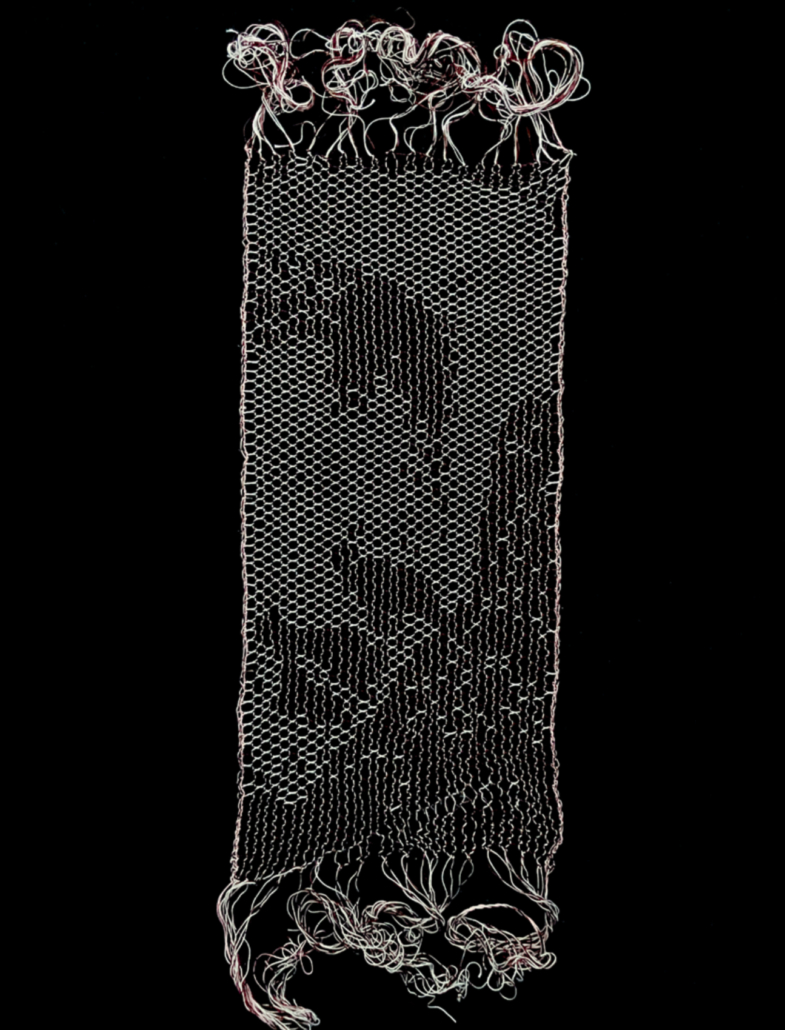
Sasha Baskin
After Angelica (Sappho Inspired by
Love) 2023
Bobbin lace, two-toned tulle technique;
silk thread; 13” x 4.5” unframed
This portrait, referencing Sappho Inspired by Love by Angelica Kauffman, is part of a larger series of work exploring modern mythological systems through the lens of pop culture and digital imagery. Through the use of the two-toned tulle technique, the Renaissance portrait is pixelated and broken down into dark and light pixels, or dark and light crossed threads. The image explores the relationship between the mythological rendering, the modern mythology of the digital image, and the relationship both have to the screen and concept of simulation and simulacrum.
Sasha Baskin’s lace and weaving practice explores the intersection of craft and classical rendering. She uses traditional weaving and lacemaking processes in combination with pop culture imagery to discover the intersections between analog and digital technology. Trained in classical drawing, Baskin received her BFA from the Maryland Institute College of Art in 2014. She received her MFA in Craft and Material Studies from Virginia Commonwealth University in 2018. She is currently a full-time lecturer in the Center for Visual Arts at Johns Hopkins University.
Image courtesy of the artist.
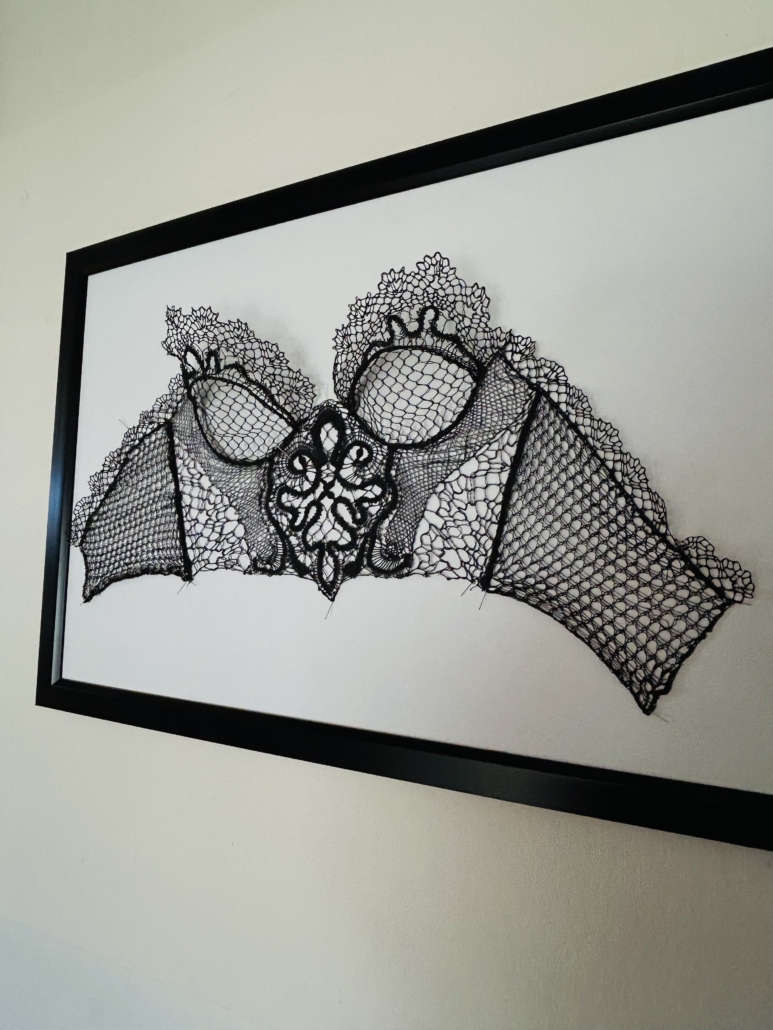
Padina Bondar
Padina Bondar, 2022
Bobbin lace, knitting, needle lace, and
CNC cutting; hand-spun discarded
LDPE (black trash bags); 22” x 32”
framed
This lace bodice is made of discarded plastic bags found in the streets of Manhattan that are spun into a high quality, viable yarn using a proprietary technique. It features a variety of lacemaking methods including bobbin lace, needle lace, knit lace, and CNC cut lace.
Padina Bondar is an award-winning designer, artist, and all-around maker with extensive production, research, and technical abilities in textiles, fashion, and sustainability. Padina is best known for her avant-garde creations using alternative materials and integrating traditional craft and modern-day technology. Her mission is to deliver meaningful outcomes to projects and problems across the design spectrum with intersectionality, justice, equality, sustainability, and ethics at the forefront of her narrative spinning yarn, making lace, developing proprietary tools, and turning trash into wondrous treasures.
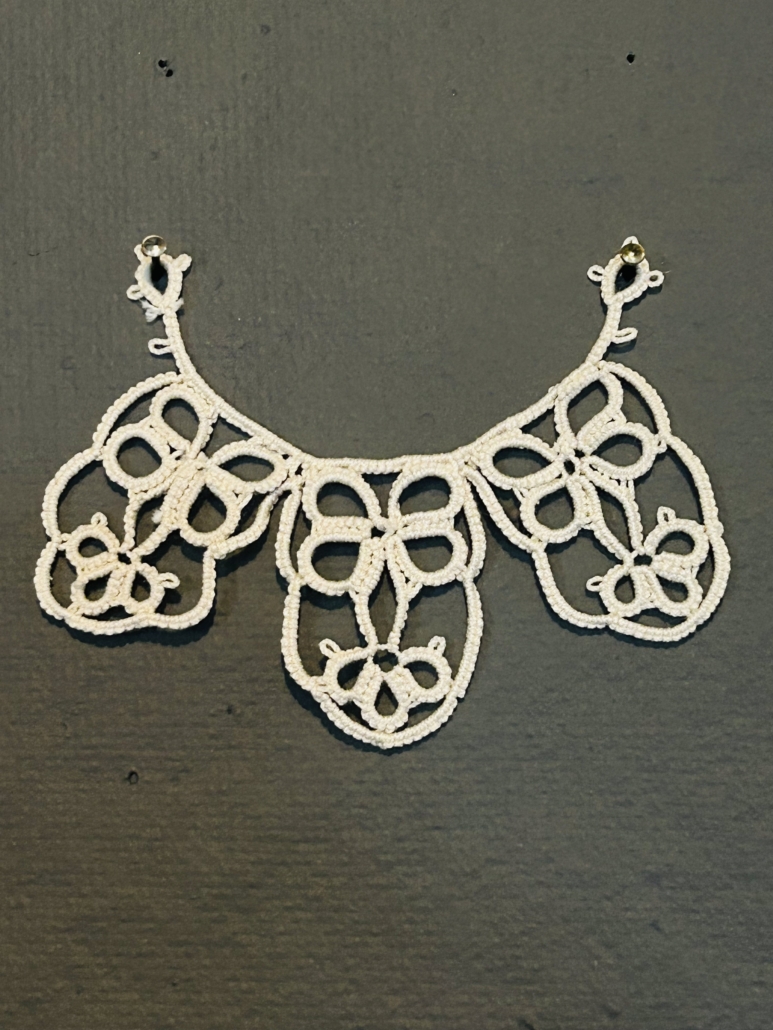
Ev Christie
Untitled (After a Wrought Iron Grate), 2024
Tatted lace; cotton thread, 3.25” x 4.5”
This piece is inspired by a nine-teenth-century architectural drawing for a wrought iron fence or window grate. With my background in black-smithing, I was eager to see if the patterns in wrought iron fencing could be translated into lace—bringing the
cold, hard iron to a softer, more malleable lace. The two media have very similar traits: creating openings that allow the viewer to peer through, but not allowing for a full uninterrupted view of what lies beyond.
Ev Christie is a multimedia artist from Detroit currently based out of Hell’s Kitchen. They draw inspiration from historic works of art, often clashing two contrasting ideas against each other to create a new perspective upon viewing the original works. Ev began pursuing lace as a way to continue their artistic practice while in New York without access to their traditional media of ceramics and metals.
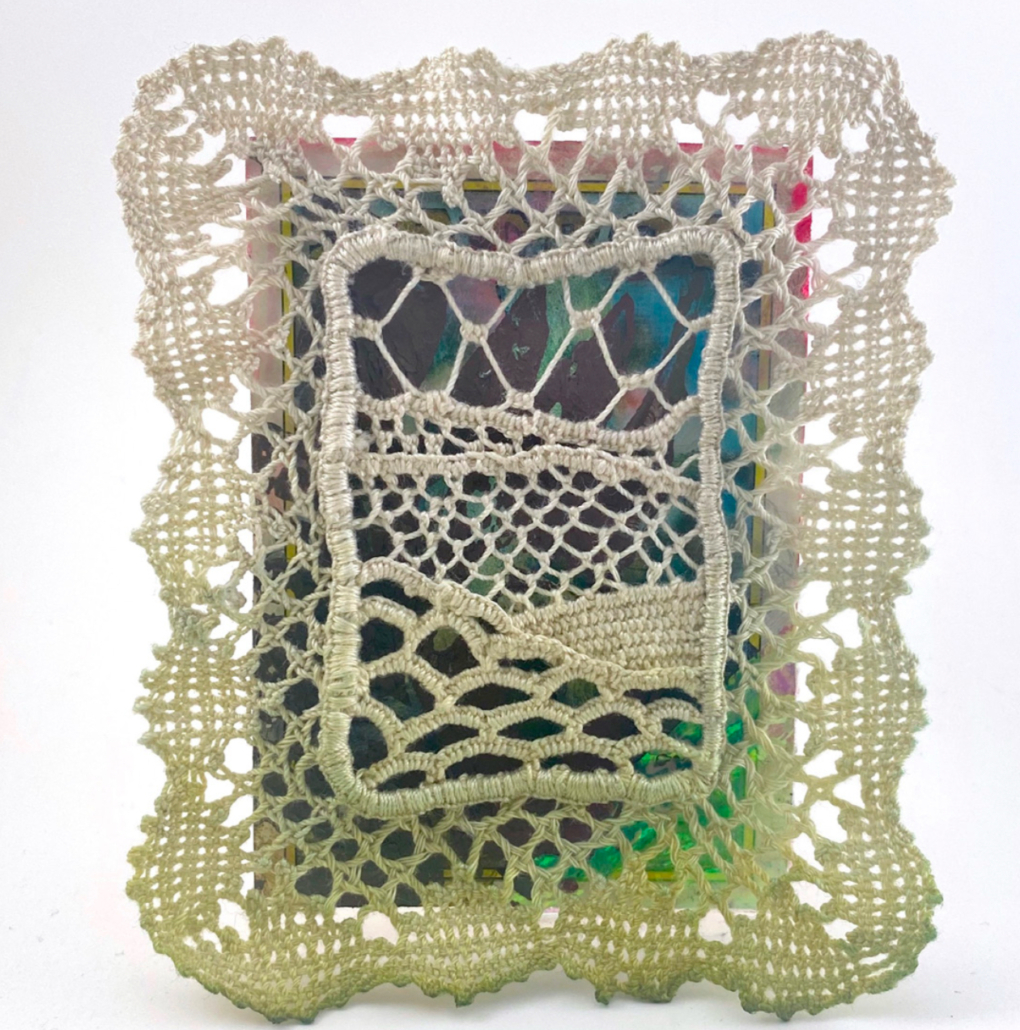
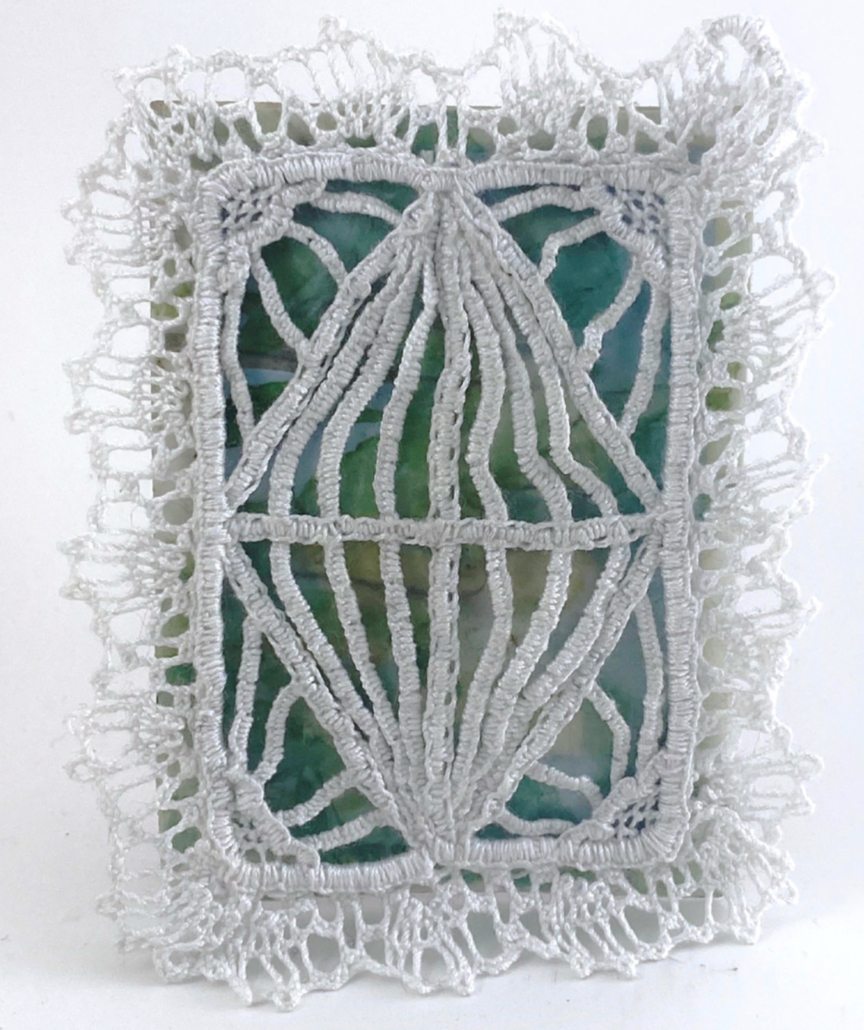
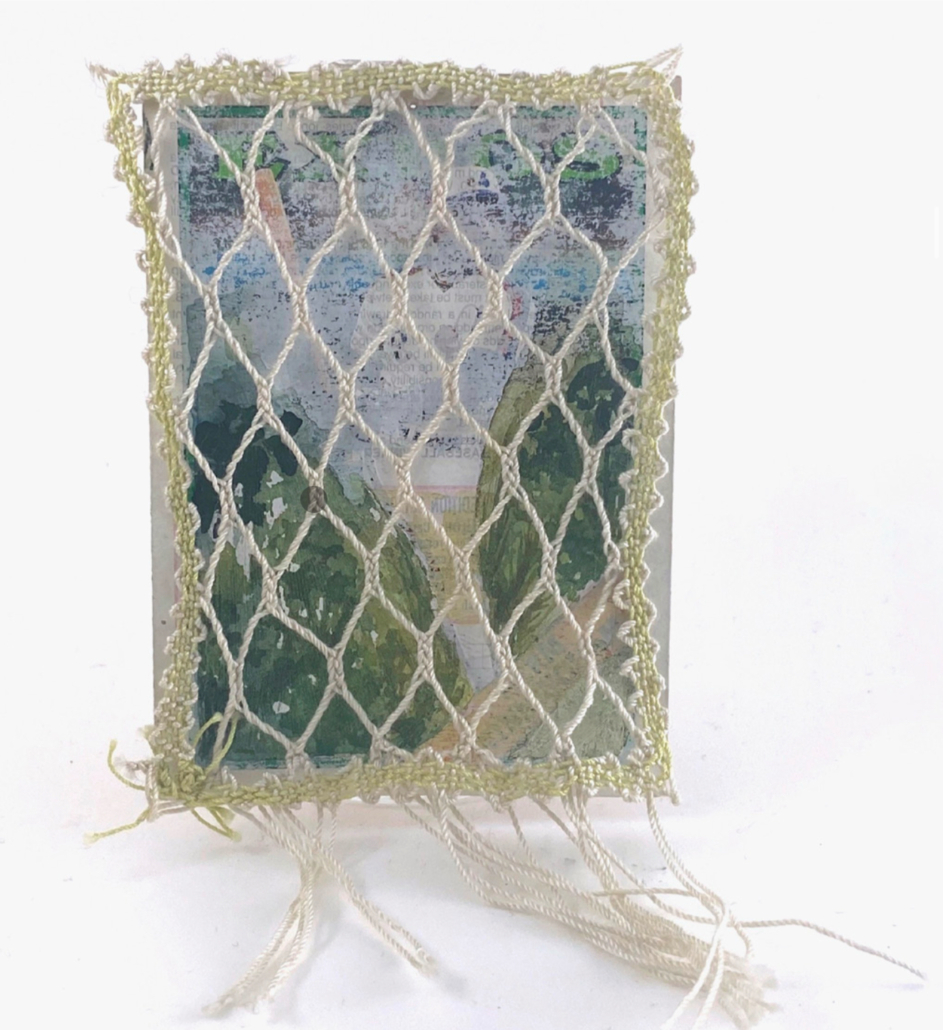
Glorimar Garcia
Velo 3 / Rejas de Maria, 2023
Bobbin lace, needle lace; cotton thread, coffee, mixed media on baseball card
4” x 3” x 1” unframed
Velo 1 / Verja, 2021
Bobbin lace; cotton thread, mixed media on baseball card; 4.5” x 3.5” x 1”
Velo 2 / Detrás del monte, 2023
Bobbin lace, needle lace; cotton
thread, coffee, mixed media on base-
ball card; 4.5” x 3.5” x 1”
In 2013, I saved a collection of water damaged sports cards from being thrown away and began using them in a series of paintings and sculptures. I eventually realized the identity, culture, and gender implications inherent in my salvaging and manipulating these cards.These pieces are the first in my series of “Velos” or Veils. The veils themselves are made of bobbin and needle lace and bring in elements of architecture or landscape from my family’s homes in Puerto Rico while also recalling religious coverings. The veils are then layered over mixed media baseball cards both obscuring and inviting the viewer to look closer. This series of work has become the group of work most closely tied to both my Puerto Rican heritage and my family’s history.
Glorimar Garcia is a Brooklyn visual artist, curator, and arts administrator. Born and raised in Ohio, she studied Painting and Art History at the Art Academy of Cincinnati. Rooted in personal experience and research, her work explores aspects of identity, memory, culture, and gender. Garcia merges materials and found objects, salvaging discarded items like baseball cards to explore and manipulate their meaning. Significant projects include Cards for Puerto Rico, a benefit exhibition following the devastating hurricanes in 2017, and working with the Kurt Kocherscheidt Estate to create the first digital database of the artist’s work.
Jen Chen-su Huang
to regard a wave, 2023
Pigment print, 22” x 30”
Edition 1 of 5
Cotton cyanotype of handmade bobbin lace and machine lace; handwoven cotton and wool-nylon-metaloplastic blend (warp) with cotton, merino wool, and mohair (weft), macaroni, and wooden stretcher bars; 12.75” x 9”
As a beginner lacemaker, I have been practicing basic bobbin lace stitches to create forms that I have been meditating upon for the past few years, such as a lattice window and a spiral. I’m also interested in this early photographic method of cyanotypes, which was a way of transmitting lace patterns from teacher to student and around the globe. Lacemakers would prick the blue photograph, attending to the meandering waves inscribed by light rays. The title is indebted to Sora Han and her forthcoming book of poetry, : to regard a wav
Jen Chen-su Huang is an artist and writer, whose process-driven works interweave strands of craft theory, translation, history, and memoir. She is the recipient of a U.S. Fulbright Fellowship, and her practice has been supported by Luminarts and the Textile Society of America, among others. She holds a BA from the University of California, Berkeley, a MFA from the School of the Art Institute of Chicago, and is currently a PhD candidate in Performance Studies at NYU Tisch and a part-time lecturer at Parsons School of Design.
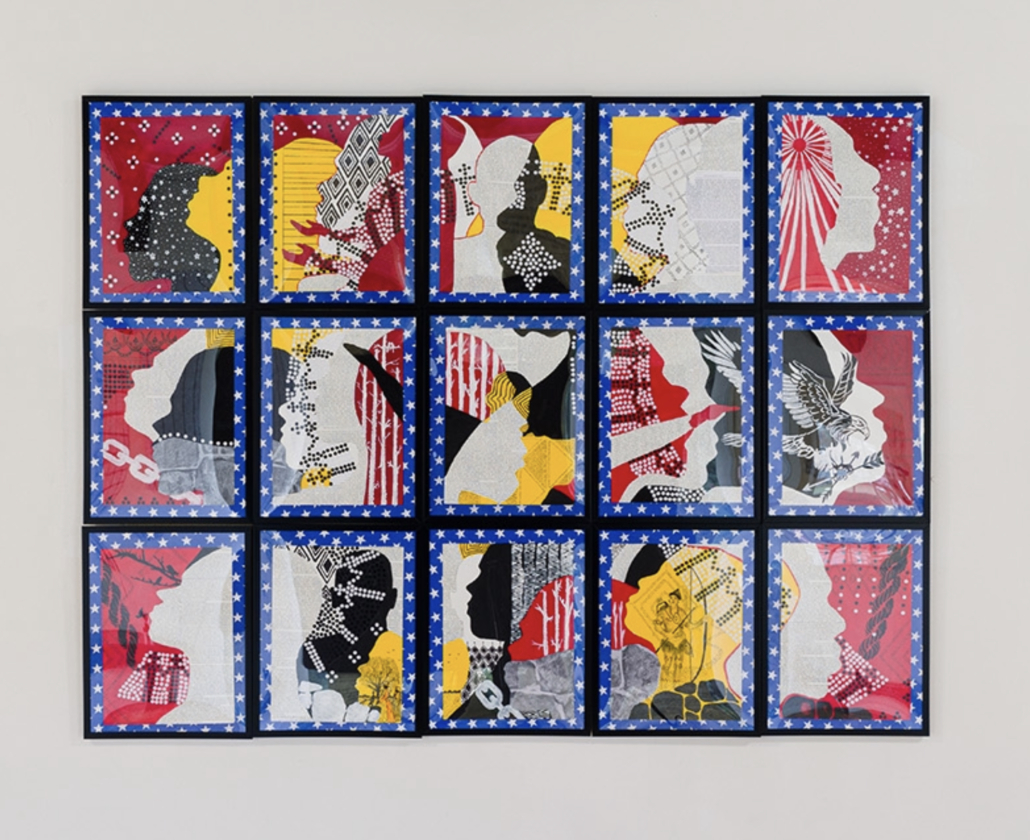
Dennis RedMoon Darkeem
Legacy of the Land: Unveiling the Indigenous Influence, 2023
Painting and collage on paper, 48” x 60”
This work reflects on Indigenous influence on American government and the complex legacy of James Madison. It was inspired by a visit to Madison’s Montpelier estate in Orange, Virginia during a local artist residency. The estate has since become a museum and a place of historical significance. This artwork serves as a stark reminder of the labor that sustained such grandeur, with more than 500 enslaved individuals toiling on the property and thousands more sent across states for various laborious tasks. Through a fusion of Civil Rights imagery and excerpts from James Madison’s writings, it underscores the often-overlooked contributions of Indigenous and Black communities in shaping the Constitution. Four colors, representing the medicine wheel (an ancient and sacred symbol used by many tribes) serve as a visual tribute to humanity, the changing seasons, the elemental connection to the land and the four cardinal directions.
Historic background
James Madison, the fourth President of the United States and often referred to as the “Father of the Constitution,” played a pivotal role in shaping the nation’s foundational document. Alongside Alexander Hamilton and John Jay, he authored The Federalist Papers, advocating for the Constitution’s ratification. My artwork delves beyond the conventional narrative, shedding light on how Madison’s vision of a powerful federal government echoed imperialist ambitions reminiscent of the Roman Empire. This perspective raises important questions about the treatment of Indigenous peoples and their ancestral lands in the context of the Constitution.
I also explore the influence of the Iroquois Confederacy, composed of the Mohawk, Onondaga, Oneida, Cayuga, Seneca and Tuscarora nations, on the Constitution’s framing. This influence even extends to the adoption of the bald eagle as a national symbol. The Iroquois Constitution, known as the Great Law of Peace, provided a framework for governance including a model of federalism. It was finally formally recognized for its contributions by a 1988 Senate resolution. This ancient constitution, dating back to 1450, organized Iroquois society and emphasized principles of unity and sustainability epitomized in the Seventh Generation Principle where the decisions made at any given time should result in a sustainable world seven generations into the future.
Additionally, my work references the Constitution’s treatment of slavery. The original document contained provisions that acknowledged enslaved individuals as “other persons” and established the infamous Three-Fifths Compromise which counted three out of every five slaves for representation and taxation.
I hope that my work challenges us to reevaluate the roots of the Constitution and its complex relationship with Indigenous and African American communities while contemplating the path to a more equitable future.
Photographed by Etienne Frossard.
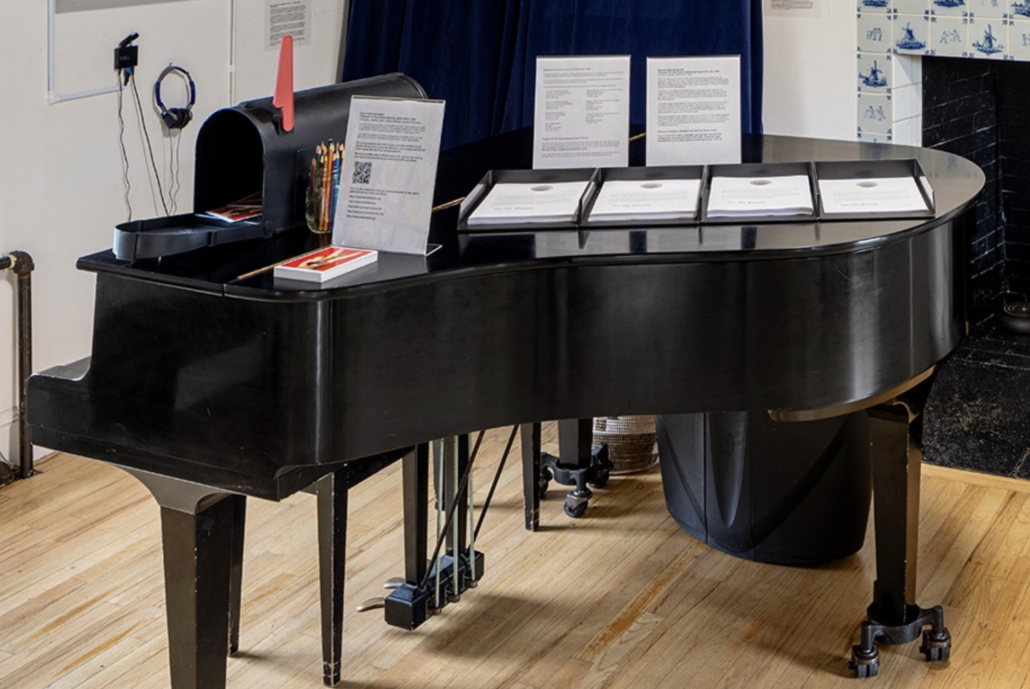
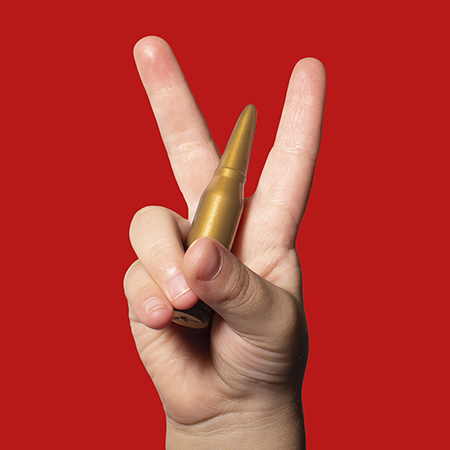
Ileana Doble Hernandez
Postcards for Gun Control (Mommy, what is this?), 2018
Postcards, mailbox, pens, elected officials’ contact information
The front of the postcard shows a photograph of my son’s hand holding a toy bullet while making a peace sign. The back of the postcard contains a short letter with the phrase “No more children should die from gun violence. I support gun control.”
This project was inspired by my personal experience immigrating to the U.S. from Mexico around the time of the Sandy Hook Elementary School mass shooting.
Fill out a postcard to advocate for gun control by sending it to an elected official. At the end of the exhibition, all postcards will be sent to the elected officials these are addressed to.
We have provided a list of officials local to NY, but you may look up your specific representatives by clicking here.
You may also research current gun control proposals, or take part in additional actions, at the links below:
https://www.gaysagainstguns.net/
https://www.gunviolencearchive.org/
Photographed by Etienne Frossard. Postcard image courtesy of the artist.
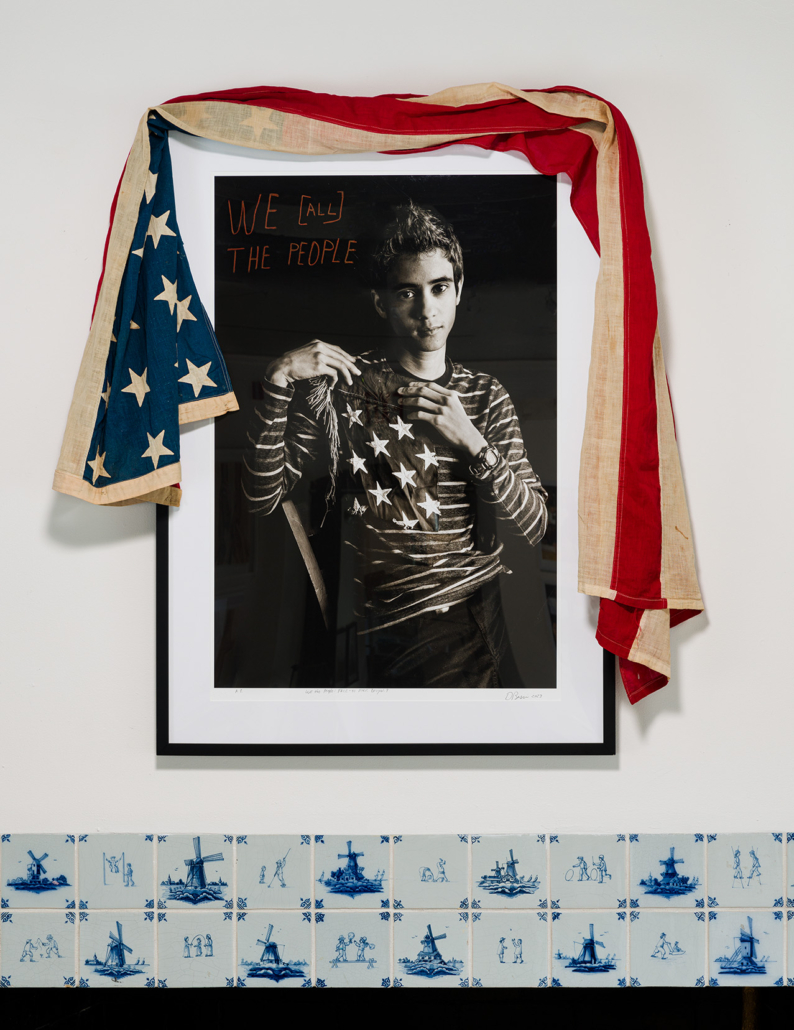
Donna Bassin
We the People: FACE-to-FACE.Devyn.9
Archival pigment print; repurposed American flag, 31” x 43”
“My name is Devyn and I am a Latino trans man living my truth. I am proud of my gender identity and am grateful for all the amazing and supportive people I’ve met and been able to work with because of my visibility. I choose to be visible for various reasons, one of the main reasons being that I want other trans folks, especially trans youth, who are struggling with their gender identity to know that they are not alone and can be their true selves – even though our current political climate is trying to take away our basic human rights and protections. I want America to see that we are all just human beings and deserve to be treated with the same kindness and respect as our fellow straight cis humans.” ~ Devyn Nunez
“We the People: FACE-to-FACE is an invitation for the viewer to encounter and engage with an ongoing portrait project, My Own Witness, which began in response to the aftermath of the 2016 presidential election when the limited effectiveness of the Constitution became more visible. I asked my portrait sitters to turn themselves ‘inside out ‘ and to use pose, gesture, gaze, and props, such as the American flag, to represent their own experiences of the current crisis of democracy and constitutional law. While the American flag has become a complicated symbol, most of my sitters reclaimed and reimagined it to express their distress, defiance, and/or respectful hope for genuine democracy and liberty.” ~ Donna Bassin
Photographed by Etienne Frossard.
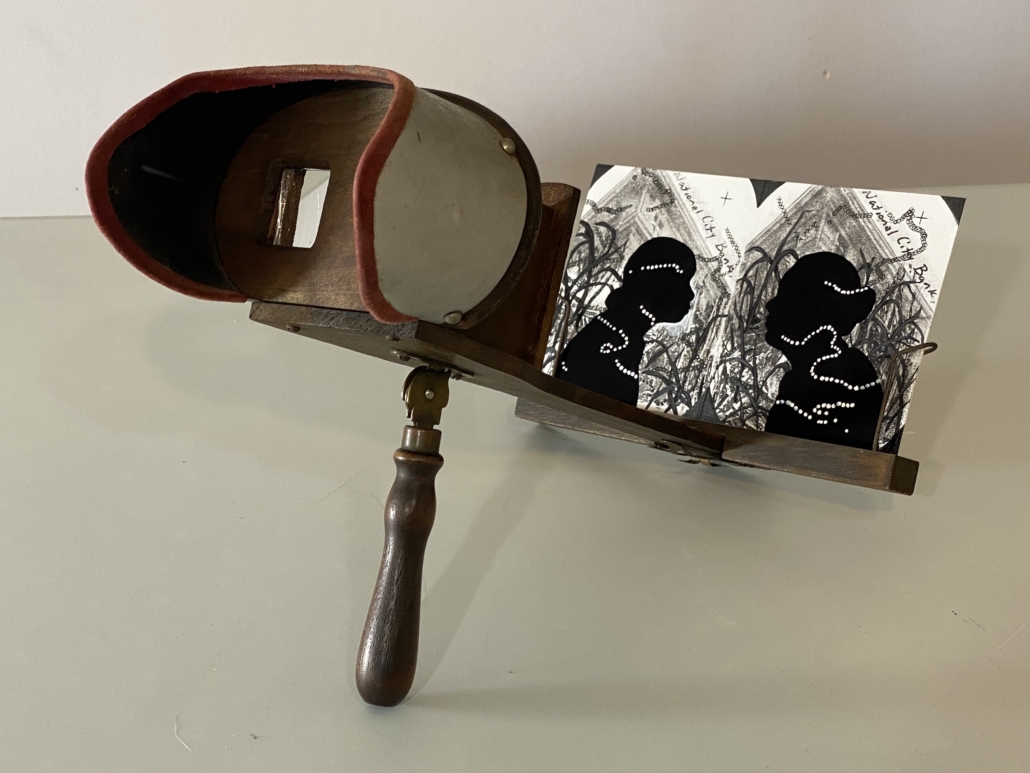
Alex Callender
A case of memory, whether the sugars were never ours, 2023
Mixed media drawings and wood stereoscopes, each 12″ x 12″ x 15″
Thinking metaphorically about sightlines and borders, this series of drawings viewed through stereoscopic frames combines archival documents with early 20th century American foreign policy narratives in the Caribbean, remixed with economic and social histories enabled by the 1901 Insular Cases.
The Insular Cases are a series of Supreme Court decisions regarding the status of U.S. territories acquired during the Spanish–American War that still govern these territories today. They are widely considered racist in their language and intent, creating unequal access to citizenship, mobility, land, labor rights, economic sovereignty and ecological justice in the hemispheric divide of the Americas. Residents of unincorporated territories (those not on a path to statehood) including Puerto Rico, the Philippines and Guam have not been given full constitutional protections. While the cases themselves were meant to consolidate questions of US extra-legal constitutional power in these newly acquired territories, the history of intertwining American corporate and banking interests in Cuba, Panama, Haiti and the Dominican Republic tell an adjacent narrative of how economic power shaped border relationships between the US and the Caribbean in the early 20th century. The Insular Cases affected how we think of U.S. citizenship and border politics in the age of American economic imperialism and the reimagining of manifest destiny in the 20th century. Today, many legal scholars refer to the Insular Cases as a constitutional justification for colonialism outside United States boundaries.
Stereoscopic frames are a 19th-20th century tool of sight and illusion. They were often a means to circulate tourist trading cards as a way of making “far off” places come to life. These drawings ask viewers to think about how power is revealed or disassembled through constitutional narratives and artifacts of American imperialism.
Click here read the related Supreme Court decision: U.S. Supreme Court, DeLima v. Bidwell, 182 U.S. 1 (1901) No. 966. Argued January 8-11, 1901. Decided May 27, 1901.
Image courtesy of the artist.
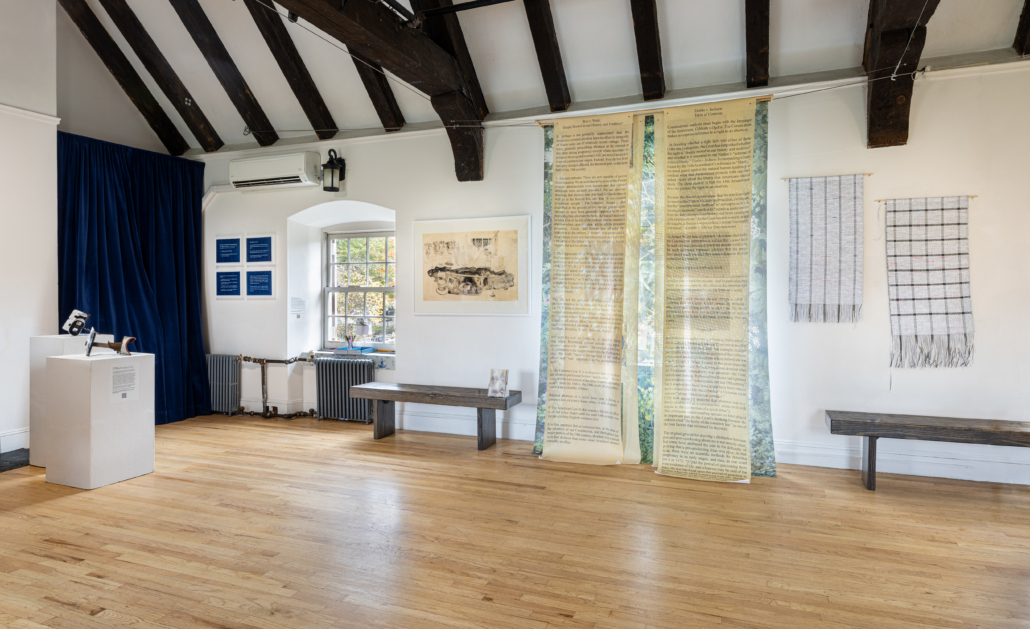
Maya Ciarrocchi
28th Amendment prints, 2023
Top row, L-R: Amendment 1, Amendment 2
Bottom row, L-R: Amendment 3, Amendment 4
Cyanotypes on paper, 11” x 14”
From Remedy for a Constitutional Crisis, a durational reading of the U.S. Constitution by multiple performers in multiple languages
Remedy for a Constitutional Crisis is an ongoing project conceived in response to the 2016 election and inspired by Burt Neuborne’s book Madison’s Music. Neuborne, a Professor of Civil Liberties at NYU Law School, states that the First Amendment can be read as poetry, and he challenges the literal or originalist interpretation of the document.
Remedy for a Constitutional Crisis comprises a durational performance of the U.S. Constitution by multiple performers in multiple languages; facilitated long table discussions on topics such as the separation of powers, Federalism, and individual rights; and areas where attendees write their own amendments or modify existing ones. Remedy for a Constitutional Crisis was presented at Abrons Art Center in 2017 and Smack Mellon in 2020.
The cyanotypes of four proposed Amendments to the US Constitution exhibited here are just some of the participatory writings gathered during the above iterations. The authors chose to remain anonymous.
Remedy for a Constitutional Crisis will be performed outside the Old Stone House on Sunday, October 29, 2023 (rain date Saturday, November 4, 2023) from 11am – 3pm.
Use the index cards provided to write your own 28th Amendment and leave it in the tray!
To see Remedy for a Constitutional Crisis performed at Abrons Art Center, click here.
Photographed by Etienne Frossard.
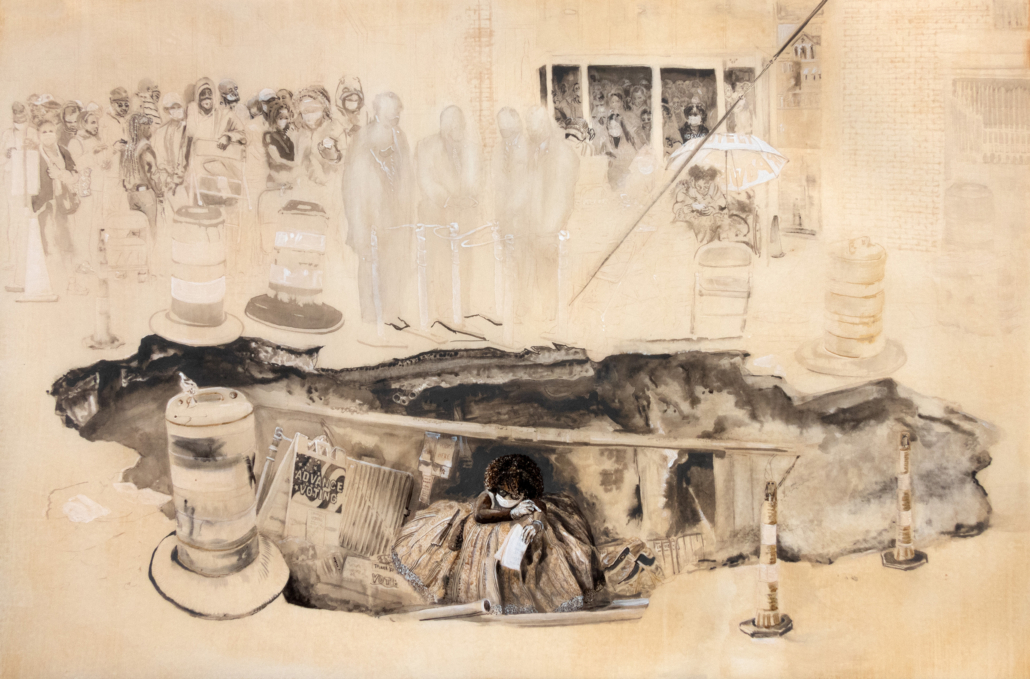
Andrew Ellis Johnson
Sinkhole, 2023
Medium ink and gouache on paper, 37.5” x 24.5” (43.5” x 31.5” framed)
There has always been a gap in the Constitution—between its ideals and the realities by which this country has been governed. At times, the gaps are horrific chasms; sometimes they begin to close, promising rights more equally distributed. My allegorical visual narratives explore the profound consequences of a constitution written by white men, the majority of them owners of enslaved people. They address ways that the ideals of the Constitution have been selectively applied or ignored, leaving many outside its stated principles and protections, particularly concerning voting rights, reproductive freedom and the right to asylum.
Sinkhole presents a ballot worker diligently performing duties in a sinkhole of suspicion and harassment, surrounded by long lines in districts purposely assigned fewer polling stations, shorter voting calendars and increasing restrictions. Above her are ghostly gerrymandering politicians who skew the democratic process, promoting disenfranchisement and undermining the spirit of our founding documents. They represent an unbroken lineage of efforts to thwart voting protections guaranteed by constitutional amendments.
Image courtesy of the artist.
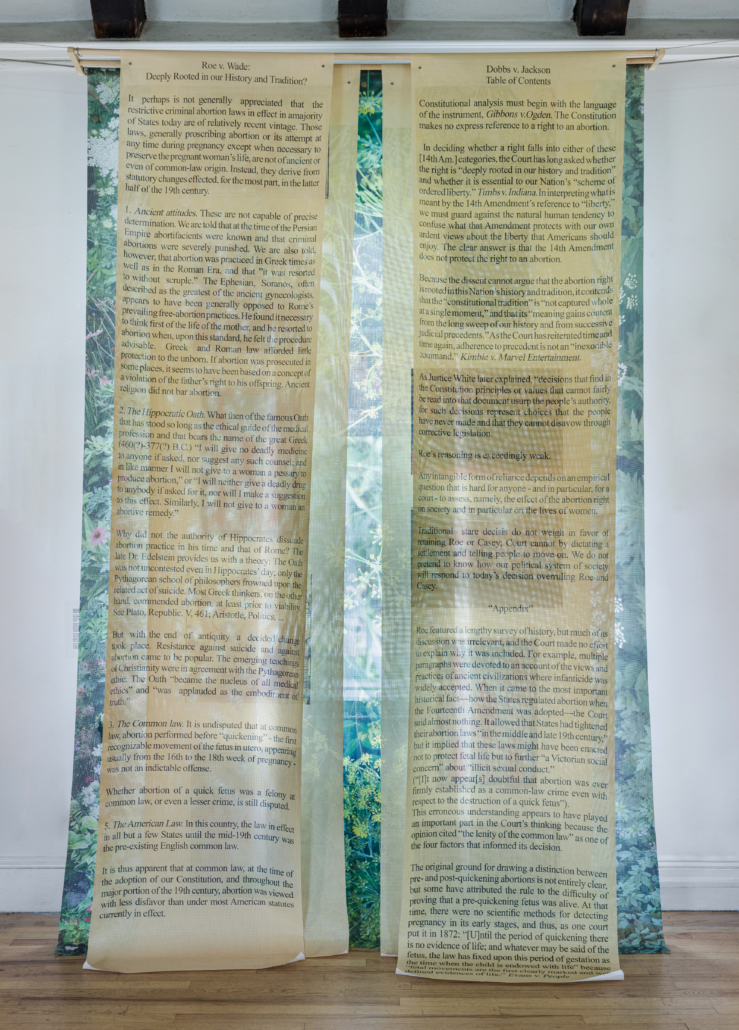
how to perform an abortion (Maureen Connor & Jason M. Leggett)
Penumbra, 2023
Printed mesh curtains, 4 curtains 25 x 116″; 3 curtains 24″ x 116″
Penumbra (def. a partial shadow, as in an eclipse, between regions of complete shadow and complete illumination) is a project and installation that challenges the constitutionality of Dobbs v. Jackson, a decision by the U.S. Supreme Court, June 24, 2022, in which the Court held that the U.S. Constitution does not confer a right to abortion.
Historically, however, justices and scholars have argued that the founding document includes a penumbra: a group of rights implied from other explicitly protected rights. The term gained attention in 1965, when the Griswold v. Connecticut decision established a right to privacy based on the 1791 Bill of Rights and explicitly the First, Fourth, Fifth & Ninth Amendments, in addition to substantive due process rights of the Fourteenth Amendment.
When the Dobbs decision calls attention to the phrase “(not) deeply rooted in our history and tradition” to explain why abortion was not a right granted in the Constitution, we ask, “whose history….whose tradition?” The answer is that abortion history is women’s history, as we draw attention to the millennia-long legacy of women using herbs for abortion and contraception, a “birthright” that is part of a deeply hidden, repressed and often destroyed global practice.
Here we juxtapose selections from Dobbs, placed on a background of images of groups of “men making serious decisions” in relation to selections from Roe, placed on a background of women taking care of other women, all against a background of herbs traditionally used for abortion and contraception.
Photographed by Etienne Frossard.
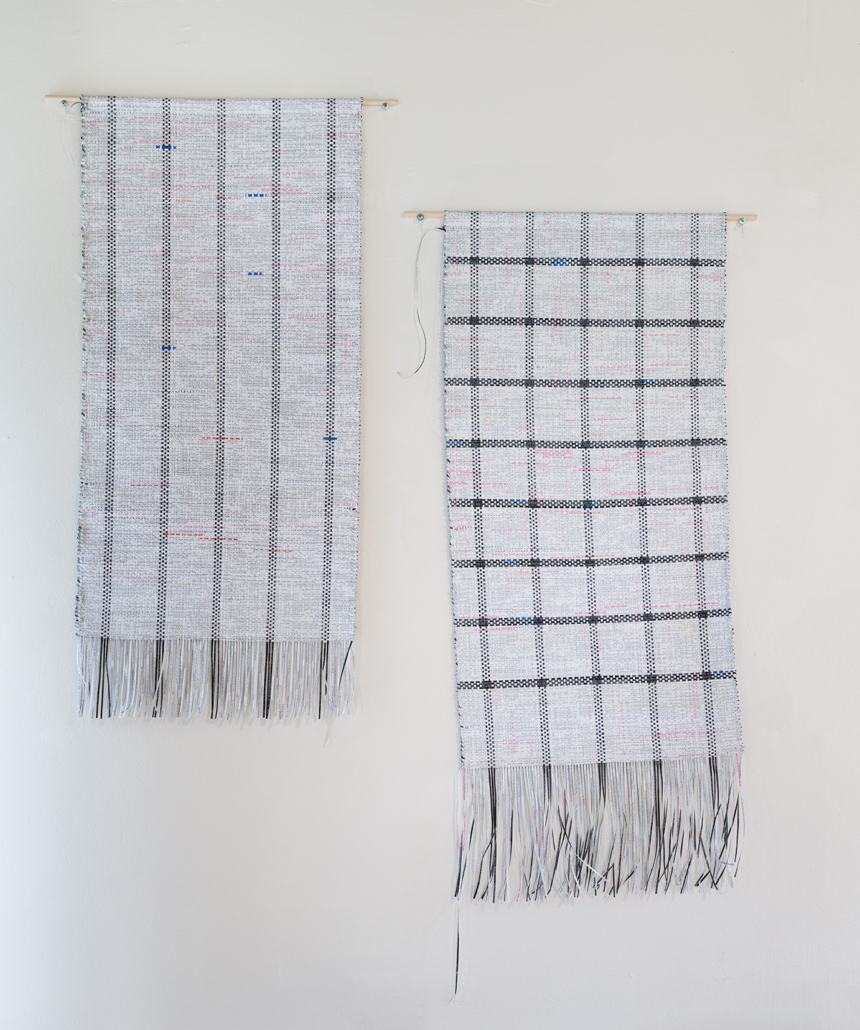
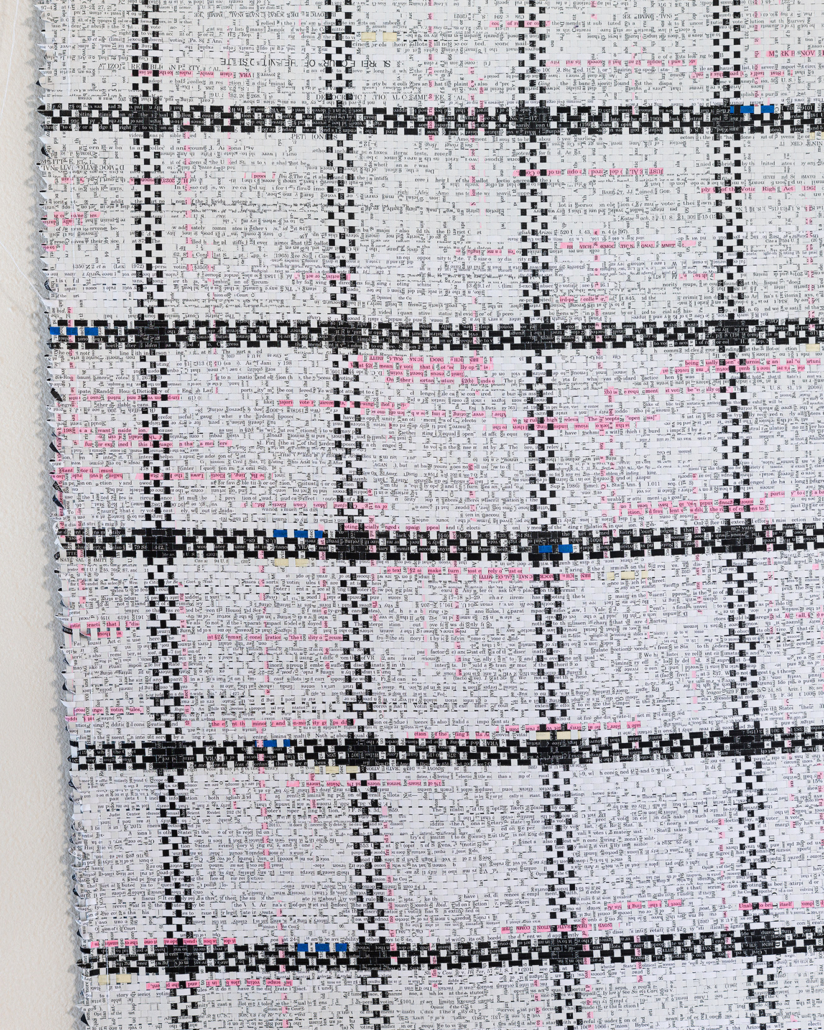
Bang Geul Han
Sam’s Kitchen Towels (Warp and Weft #4), 2023
Paper, glue, thread, 19.5” x 36” each (x 2)
Sam’s Kitchen Towels (Warp and Weft #4) is part of my ongoing series Warp and Weft (2021 – present,) in which I weave together printouts of various legal documents concerning reproductive rights and their intersections with questions of race and class.
This particular piece weaves together two opinions of the U.S. Supreme Court delivered by Justice Samuel Alito: Brnovich v. Democratic National Committee (2021) and Dobbs v. Jackson Women’s Health Organization (2022). These hugely consequential recent rulings weakened the 1965 Voting Rights Act (making it more difficult to challenge discriminatory voting laws in court) and overturned the federal constitutional protections for abortion (established by the previous Roe v. Wade and Planned Parenthood v. Casey rulings), respectively.
Justice Alito’s assertion of his originalist textual interpretation of the Constitution intersects and overlaps through warp and weft, creating a physical manifestation of the interlocking sociopolitical frameworks that perpetuate gendered and racial violence.
Photographed by Etienne Frossard.
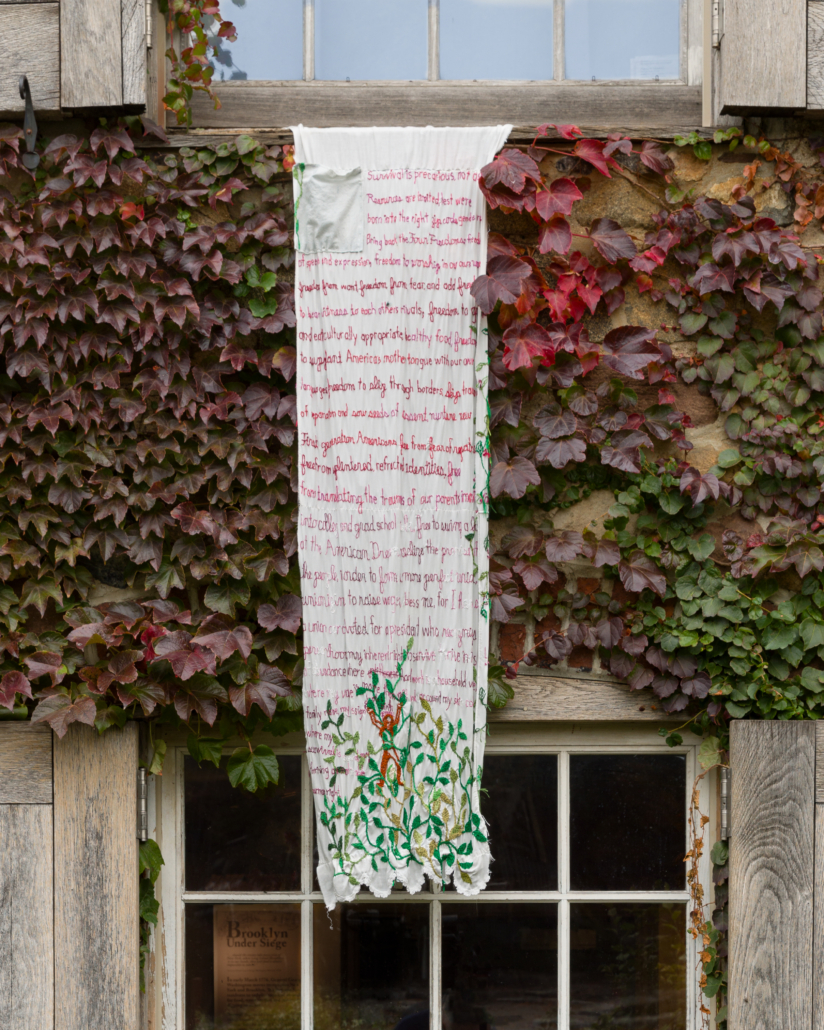
Iviva Olenick
Survival is precarious, not assured, 2019
Embroidery on fabric with indigo-dyed pocket, 50” x 18.5”
$850
I made this piece while creating a series of flags “talking back” to then President Trump, the Constitution as it was originally written, and contemporary interpretations of the Constitution that limit rather than protect personal freedoms. The piece directly advocates for reviving the “Four Freedoms” articulated by President Franklin D. Roosevelt: freedom of speech and expression; freedom to worship in our own ways; freedom from want, freedom from fear. It goes further to advocate for freedom to practice cultural, religious and personal rituals without fear of discrimination or retaliation, and to thrive rather than merely get by.
Photographed by Etienne Frossard.
About the Curator:
Katherine Gressel, the Old Stone House & Washington Park’s Contemporary Art Curator, is a New York‐based curator, artist, and writer focused on site‐specific art. She earned her BA in art from Yale and MA in arts administration from Columbia. Katherine’s previous exhibits dealing with such topics as income inequality, urban agriculture, and parks have been recognized by the New York Times, Time Out New York, Hyperallergic, News 12 Brooklyn, and DNAInfo. In addition to organizing eleven major exhibitions to date at the Old Stone House, Katherine has curated for FIGMENT, No Longer Empty, St. Francis College, and Brooklyn Historical Society, and was the 2016 NARS Foundation emerging curator. She was selected for the 2015 Independent Curators International (ICI) Curatorial Intensive in New Orleans. Katherine has written and presented on public and community art issues for Createquity, Americans for the Arts, and Public Art Dialogue, among others. Katherine also served as Programs Manager at Smack Mellon Gallery from 2010-2014, and has worked and consulted for diverse nonprofits.
Artist Selection Committee:
Steven Mazie, Professor of Political Studies at Bard High School Early College-Manhattan and Supreme Court Correspondent, The Economist; Katherine Toukhy, artist and art educator; Jennifer Wingate, Professor of Fine Arts, Chair, Interdisciplinary Studies, St. Francis College; Katherine Gressel, Contemporary Curator, Old Stone House & Washington Park; Kim Maier, Executive Director, Old Stone House & Washington Park
This exhibition is made possible, in part, by the New York City Department of Cultural Affairs and the New York State Council on the Arts with the support of the Office of the Governor and the New York State Legislature.


